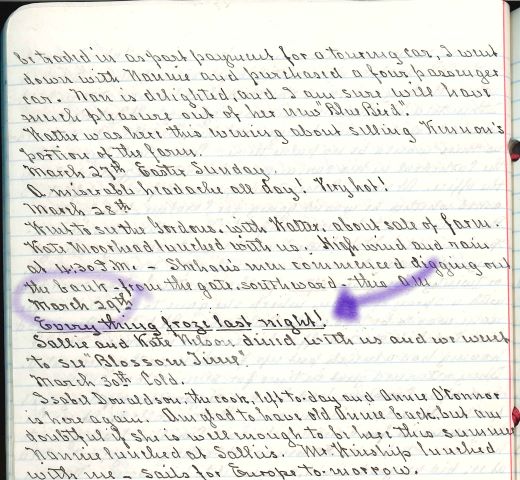Activity: Create a Journal
Armistead Peter Jr. Diary, 1921.Tudor Place Archive.
Historians use primary sources to learn about what happened in the past. Primary sources are written materials or objects that were created at the time being studied, by people who were there. For example, if we were trying to learn about the early days of Tudor Place, we might look at journals that Martha and Thomas Peter wrote.
Journals are really helpful primary sources. “Journal” and “diary” are synonyms, so they mean the same thing. Journals tell us all about what people did on a certain day and sometimes how they felt about it. The Tudor Place Archive contains lots of journals written by people who lived here. For example, if we were interested in learning what Armistead Peter Jr. was doing in the spring of 1921, we can look at his journal entries.
March 29
Every thing froze last night! Sallie and Kate Nelson dined with us and we went to see “Blossom Time.”
April 1
Clear. Mrs. Beall, the three children, and Lucy Mackall lunched here and we then went to see “Really Truly Loud.” Miss Hawk’s dancing class.
April 5
Bought set of cold tea spoons for Nan. [?] 25th. Attended Director’s Meetings at 4PM and am very thankful to find things improving. No one seems to know what the outcome of the Traction Bill, recently passed at Albany, will be, but can only hope for the best. This evening, went to see “Four Horsemen of the Apocalypse.”
Armistead Peter Jr. Diary, 1921. MS-14, Box 73, Folder 6. Tudor Place Archive.
Now we know: that it was cold at the end of March in 1921, the names of Armistead Peter Jr’s friends and we know a couple of movies he saw. It is no different today. Sometimes we write journal entries for school or to talk about our days. We can also write journal entries about what we see outside in nature.
Pick one of the prompts below to get started with your own journal entry.
Daily Life Diary |
Garden Journal |
|
|


